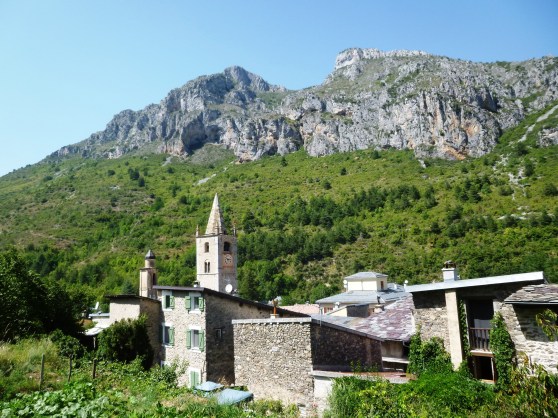
The hinterlands of the French Riviera are absolutely outstanding both in terms of natural beauty and architectural splendour and give an extra depth to a visit to this beautiful part of the world. Each valley has its own particular character, none more so than the Roya river valley that stretches in the extreme eastern part of the Maritime Alps, between France and Italy. A summer visit is an ideal way to escape the summer heat and there are some absolute gems, such as La Brigue, a medieval village tucked away just off the main road, and Notre Dame des Fontaines, also known as the “Sistine Chapel of the Southern Alps” thanks to its beautiful 15th century frescoes, which I will be covering in this article although there is much more to see.
This excursion that can easily be done in a day from the coastline in Nice or Monaco or else on the way up to Turin and Piemonte in Italy and will enable you to discover some spectacular mountain scenery without having to take any difficult mountain roads, whilst enjoy some great food and drink and simply enjoy the culture shock compared to the busy resorts of the coastline.
Some quick background information about the Roya valley
The Roya is a rather short, 59km long mountain river originating in the French Maritime Alps just before the Col de Tende: it winds its way down towards the coast past the French villages of Tende, La Brigue, Saorge and Breil sur Roya before crossing into Italy and finishing up in the Mediterranean in the centre of Ventimiglia.
The Roya valley however is much more strategic than its length suggests as it has always been the fastest route linking the large cities of Piemonte, especially Turin, to the Mediterranean coast and to Nice. This was already the case in medieval times when the road up the valley was known as the “Route du Sel” (the Salt Road), because it was used by salt merchants from Provence to travel up to Northern Italy. The valley also came to be known as the Baroque route because the wealth brought by all this cross-border trading led to investment in churches during the 17th century and some splendid religious architecture that still exists to this day.
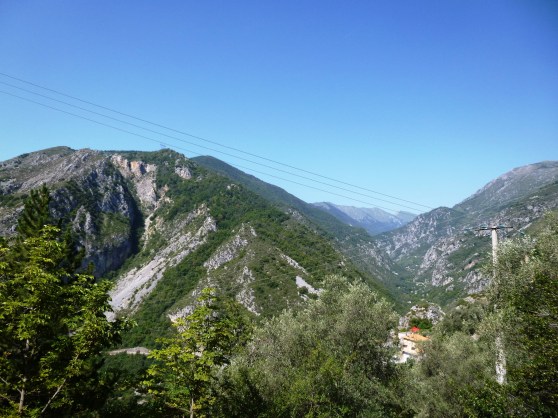
Nowadays, the route down the valley is frequently used by Italians eager to get to the French Riviera from Piemonte and is therefore pretty busy – if you carry on north past Tende, the route climbs up the side of the mountain and reaches the Tunnel de Tende, an ancient tunnel cutting across a mountain pass that was heavily guarded by 19th century fortresses, before crossing the border into Italy and reaching the towns of Limone Piemonte and Cuneo, which are also worth visiting as I will explain in one of my next articles.
La Brigue
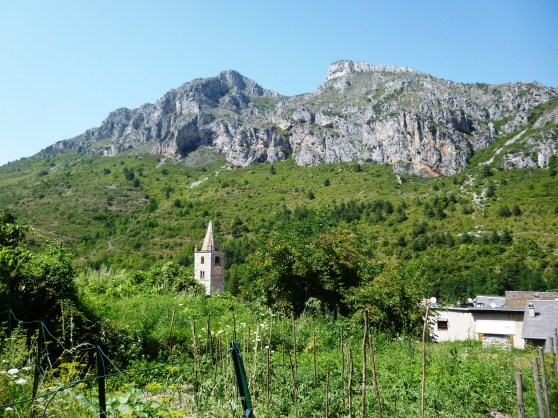
La Brigue is one of the last villages you will find heading north from Ventimiglia towards Tende, it is actually located on the Levenza river, 2km from the actual Roya. I have always found something totally unique about the character of this village which is large enough to use as a base in the evening but small enough to properly explore in a few hours, surrounded by high mountains and lots of lush vegetation. Tende, la Brigue and the countryside around them were part of Italy until 1947 when they joined France in the post-war Treaty of Paris, so this cultural mix is probably what makes the atmosphere unique. You’ll also notice plenty of Monaco number plates on the cars, this is because a great number of Monegasque residents and nationals have secondary houses in this lovely area located only 90 minutes’ drive from the Principality.
Here are some highlights of what to do during a one-hour stopover to optimise your visit to the village:
- Wander around the small streets of the old town and just soak in the atmosphere of the place and the positive vibes it exudes along with the lovely natural setting: due to its Italian origins, la Brigue has some rather unique architecture and plenty of real gems. The green colour of the buildings comes from the limestone originating from the quarries near Tende and the Vallée des Merveilles (Valley of Marvels), just above in the mountains.
- Perpendicular to the Levenza river you’ll find the valley of the Rio Sec, a mountain torrent that remains dry most of the year. The most charming part of the town is along its banks, with plenty of beautiful arcades as well as the old Jewish neighbourhood with the dark “Ghetto street” being one of the main highlights.
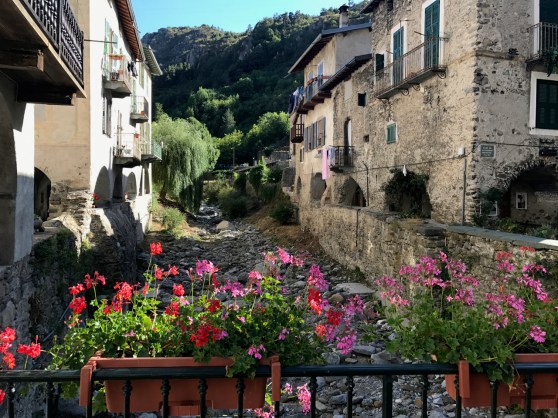
- Spot the “linteaux”(lintels) that decorate the doorway of some of the buildings: most of them are made in the characteristic green colour and represent the coats of arms of the major families during the medieval times.
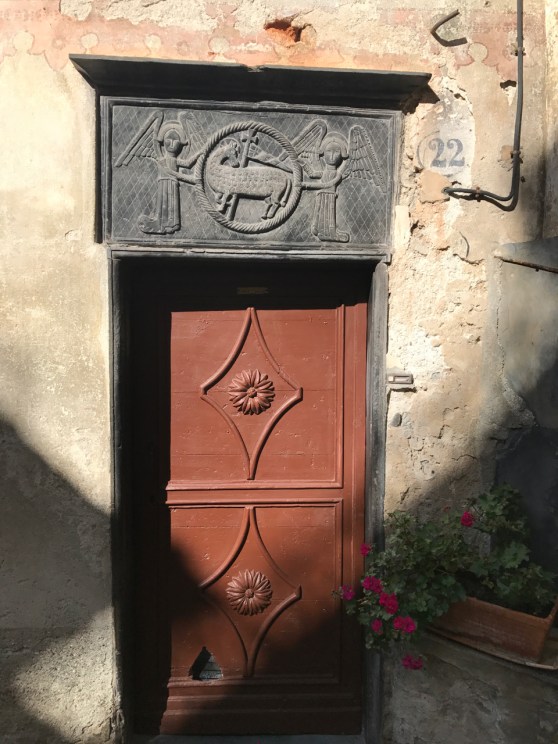
- Visit the main church, the 15th century Collégiale Saint Martin, with a stark contrast between the Gothic exterior and spire and the rich Baroque interior with beautiful artwork notably a nativity scene from one of the major local artists of the time, Louis Brea.
- If you have a bit of energy, walk up the (admittedly not very high) hill to the ruins of the 14th century Chateau Lascaris, with fabulous views over the rooftops of the village. If you check out the mountains just on the other side of the Levenza river, you can distinguish a zip line (Tyrolienne) that adventurous travellers take between the two peaks, this is part of the Via Ferrata (adventure trail): tragically due to my fear of heights and dislike of dangerous sports, I have never tried this and it is highly unlikely that I ever will!
- Grab a drink at the Bar des Platanes on Place de Nice, one of the main squares, it’s an ideal place to relax and watch the locals gossiping .
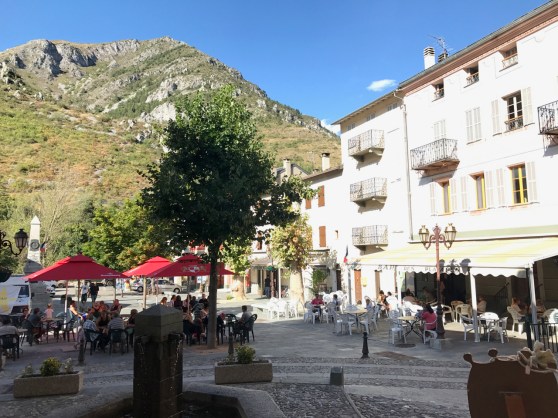
- For lunch of dinner, I would recommend Auberge Saint Martin on Place St Martin opposite the main church, a friendly place with regional specialities (such as sugeli, the local gnocchi style pasta though these sometimes need to be ordered in advance). The other 4 restaurants in the town are not bad either and worth a try though I found the service friendliest at Saint Martin.
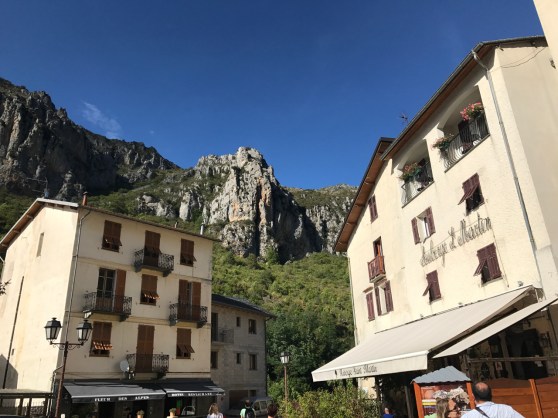
Also, in July each year, there is a rather famous Medieval Festival which is worth checking out as it highlights the historical heritage of the village, I’ll try to attend it next year.
Notre Dame des Fontaines
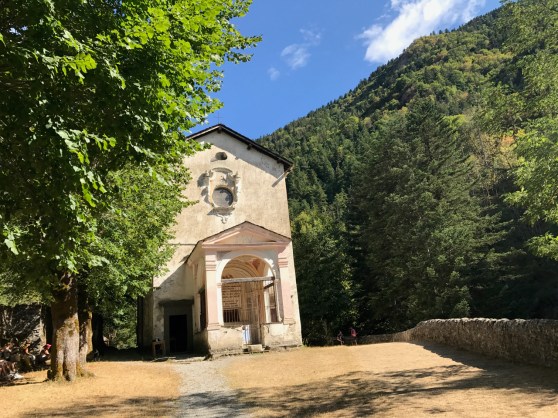
After visiting la Brigue, drive or hike 4km through some very bucolic countryside scenery surrounded by mountains (note the very original Pont du Coq, an old stone bridge at a right angle) to the secluded and wooded setting of the Notre Dame des Fontaines chapel, which is no doubt one of the top highlights of the whole valley.
From the outside, the chapel doesn’t look like much – basically it’s just a church hidden in the forest, albeit with the highest peaks of the Southern Alps looming just above. The back story is that once upon a time, the sources providing la Brigue with drinking water dried out, perhaps after an earthquake, so the inhabitants prayed to the Virgin Mary and obviously (and miraculously), the water came back. To say thanks for this miracle, the locals built the small chapel in the location of the sources, hence the name “Our Lady of the Fountains”.
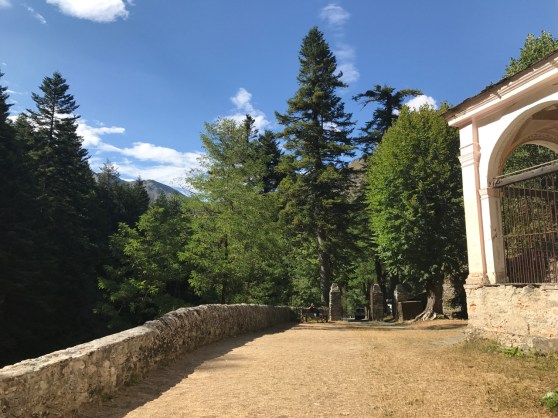
In the late 15th century, so just at the start of the Renaissance period, two Piemontese painters, Jean Baleison and Jean Canavesio, decided to decorate the chapel in an incredibly ornate and dynamic way, with wonderful frescos detailing the life of the Virgin Mary and then that of Jesus. What is amazing is that most of the frescoes remain intact from the time and have not been repainted. The frescoes were inaugurated on 12 October 1492, coincidentally the very day that Christopher Columbus first spotted land in the Americas…
When you get into the chapel (after paying the 4€ entrance fee that covers the conservation of the place), the main reaction upon seeing the tiny chapel interior covered with colours is “Wow!!!” and it’s hard to know where to start visiting. So here are some tips about how to enjoy the paintings in chronological order:
- Starting at the back of the church (the altar), the frescoes of Jean Baleision depict the life of the Virgin Mary and the Annunciation as well as the early life of Jesus.
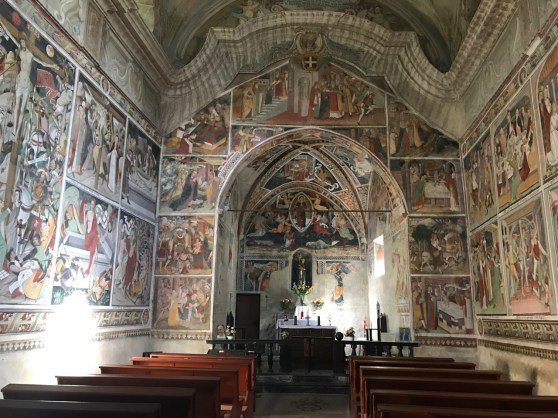
- The side walls, painted by Canavesio about the Passion of Christ, look like comic strip or graphic novel panels, not just through the way they are structured but also in the very naturalistic (and somewhat gruesome) detail. Start in chronological order with the 14 panels of the right hand wall (when facing the altar) which go from the arrival in Jerusalem on Palm Sunday to the humiliation by Herod.
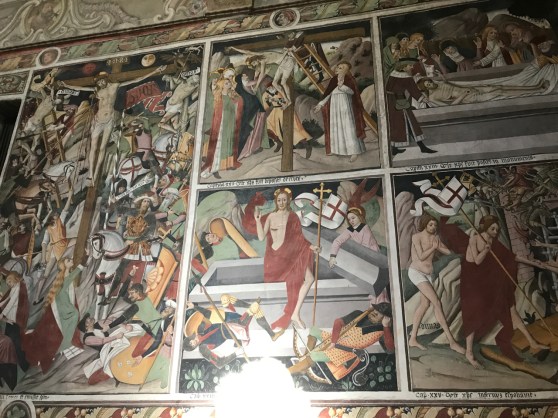
- The left hand wall is even more graphic, with the highlight being a giant crucifixion panel as well as the very famous suicide of Judas, showing some of the “punishment” he received as he was dangling – and that’s a hell of a euphemism!
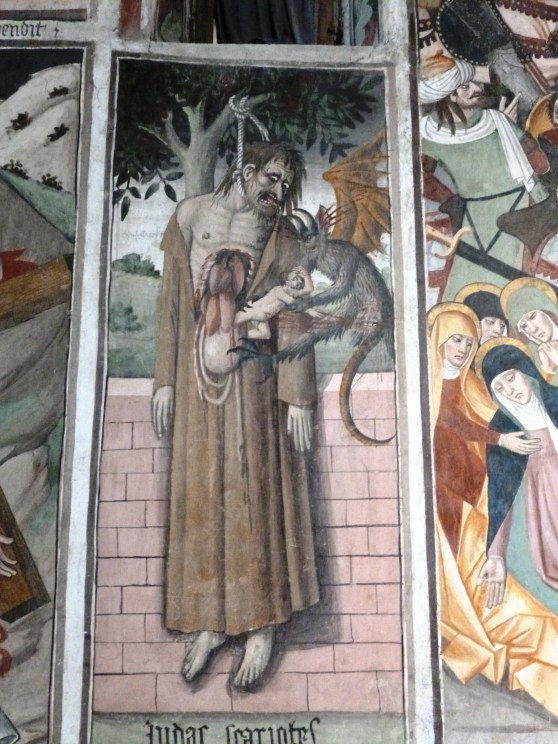
- The back wall, by the entrance, concludes the Passion cycle with a monumental fresco by Canavesio of the Final Judgement with some apocalyptic scenes of heaven and hell: basically, the artist had a free reign of what he could do and let his imagination do all the painting, especially on the parts relating to Hell, here are some pictures relating to this!
- Finally, the ceiling is very bland in comparison. That’s because some “artists” from the 17th century decided to paint it in a baroque style that doesn’t really work compared to the rest but they probably thought it was a wonderful idea at the time.
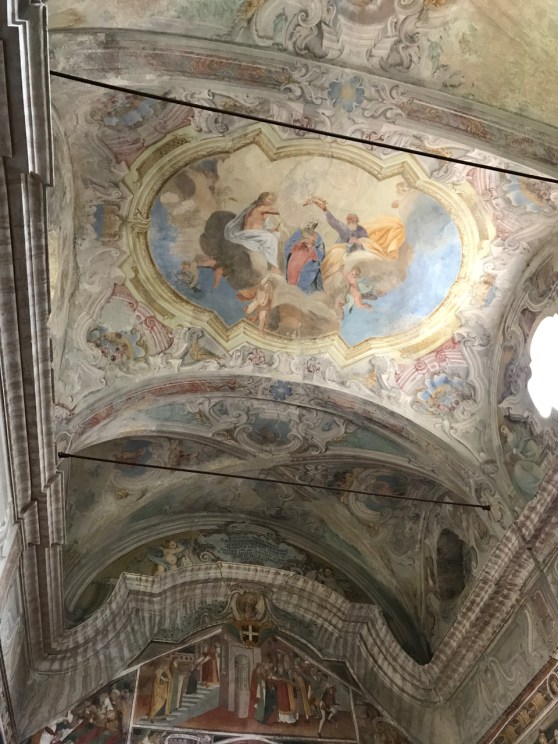
Once you are done with the visit of the inside of the chapel, have a walk around the forest nearby and take the steps down to see the “magical” sources in question, whilst breathing in the fresh air!
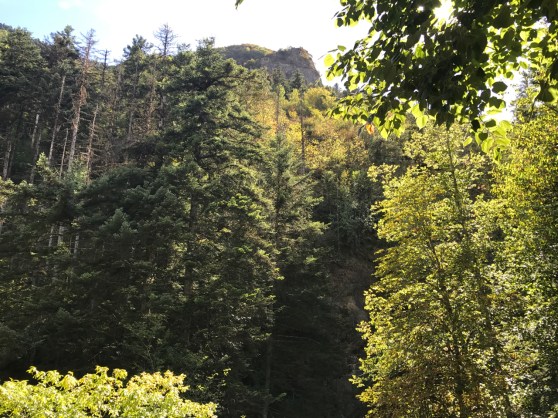
On a practical note, watch out for the opening hours on this link: it’s open every day in the morning 10am to 12.30pm and afternoon 2pm to 5.30pm (it’s closed during the lunch break) from 15 April to 15 October. Outside of this period, you need to book in advance so make sure you plan your day accordingly as you don’t want to be disappointed.
Practical information
How to get there:
- By car: by far the easiest and flexible option as anywhere in the hinterlands, just follow the A8 motorway to Ventimiglia in Italy and head north back across the French border towards Breil sur Roya and then Limone-Piemonte/Cuneo. When you get to Saint Dalmas de Tende, branch off to the right to La Brigue and then 4km later to Notre Dame des Fontaines.
- By train: you can reach La Brigue which is on the main line either from Nice station on the “Train des Merveilles” (which sometimes has a guided commentary in the summer) or from Ventimiglia, which is perhaps easier if you are travelling from Monaco. Do note however that the train lines will be suspended between Breil sur Roya and Tende for “engineering works” as per this link from 4 September 2017 to 28 April 2018, so it’s better to take the car anyway. Shame as the train ride between Breil and Tende is stunningly beautiful and a masterpiece in engineering works across the valley with helicoidal tunnels etc, let’s hope they really do reopen it next April and it’s not just a cunning plan to cancel the public transport route along this stunning valley…
After visiting these two beautiful locations which can be explored in half a day, there are several ways to carry on your journey:
- Return to La Brigue and combine with the rest of the Roya valley villages, notably Saorge to the south and Tende to the north.
- You can also use this is a stopover (like I did last week) on the way to southern Piemonte. I’ll write about this in an upcoming article.
- Stay in La Brigue or one of the surrounding villages and enjoy the nature with some hikes or 4×4 excursions around the Vallée des Merveilles. The tourist office of La Brigue can also give you some information about hiking trails
I hope you have as wonderful a time as I did discovering these gems – my first visit was in 2002 and when I have friends over for a few days, I always travel up here. Let me know if you have any feedback or comments and feel free to share your experiences either here or on the French Riviera Blog Facebook page!
Yours,
Kevin
















Thank you for an interesting post ! Is it possible to go there using the train or bus ?
Thank you !
Thanks. Yes it is, I réalised I forgot to write a how to get there section. I’ll add it later 😉
Hi again Céline, I’ve updated the post accordingly. If you want to go by train to La Brigue, it is possible but only until 4 September so you need to go quickly https://www.ter.sncf.com/paca/horaires/les-grands-chantiers/interruption-breil-tende . For Notre Dame des Fontaines, you really need a car or else to walk there (4km each way but a nice walk!), just pay attention to the limited opening hours as I indicated.
La Brigue has recently been featured in a TV travel documentary, and I realised I’ve never been and it looks amazing! I’ve got it down to visit with my in-laws in October, together with the Monastery in Sarge, have you been?
Thanks a lot for all the info it will definitely be useful!
Yes I have been to Saorge and the Monastery, it’s definitely worth checking out on the way up to La Brigue to get a complete view of the Roya Valley, glad you enjoyed my article 🙂
Fascinating. Thank you.
Very nice story and photos. In response to the question of getting to La Brigue by bus, line 905 from Menton to Tende goes up the Roya Valley via Ventimiglia and stops in La Brigue. The cost is 1.50 euros.
Hello, very interesting blog. I will be in Nice in a month’s time. Is the train line operational now?
Hi thanks for your positive comments! Yes the train line is still running up to la Brigue and Tende (but not through to Italy), enjoy your stay!
Thank you. As I discover more and more of your site, I realise that I can do so much with my time there. I should start planning well!